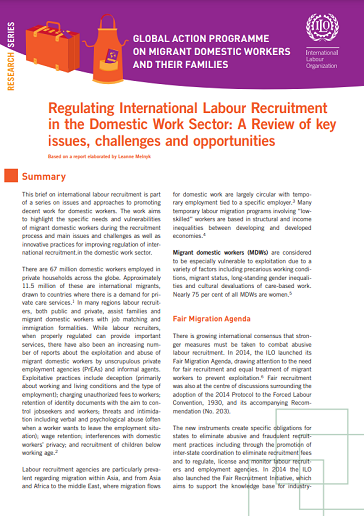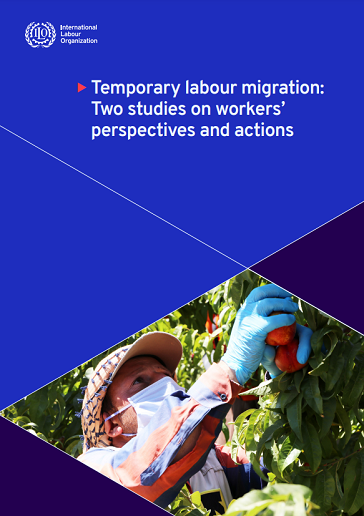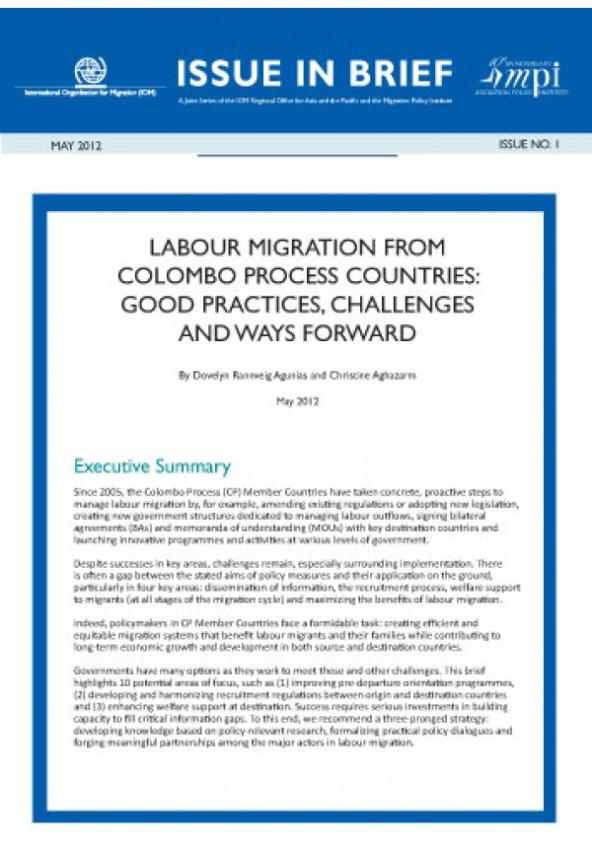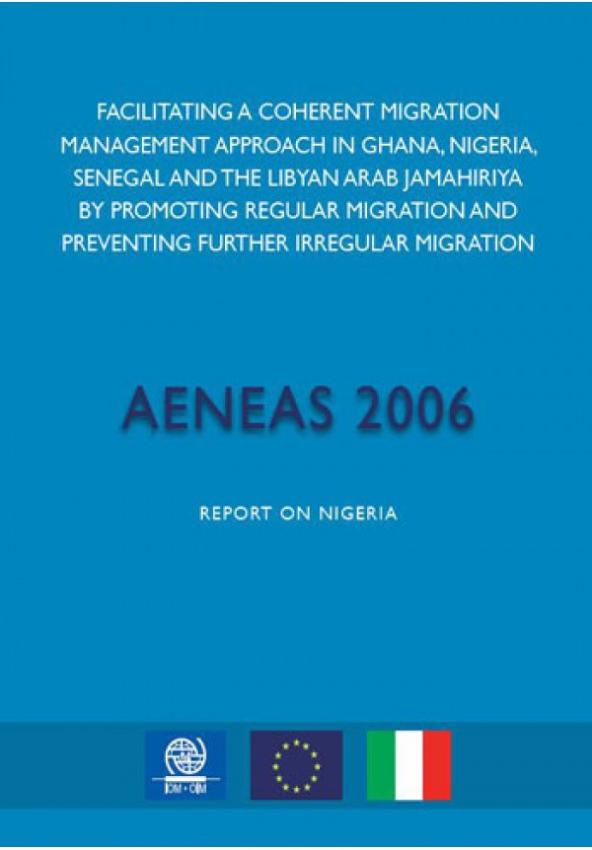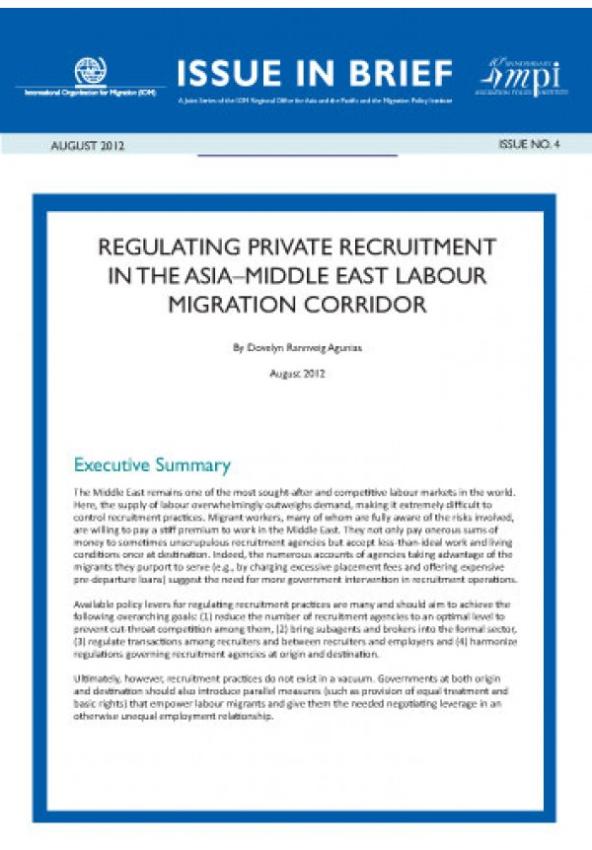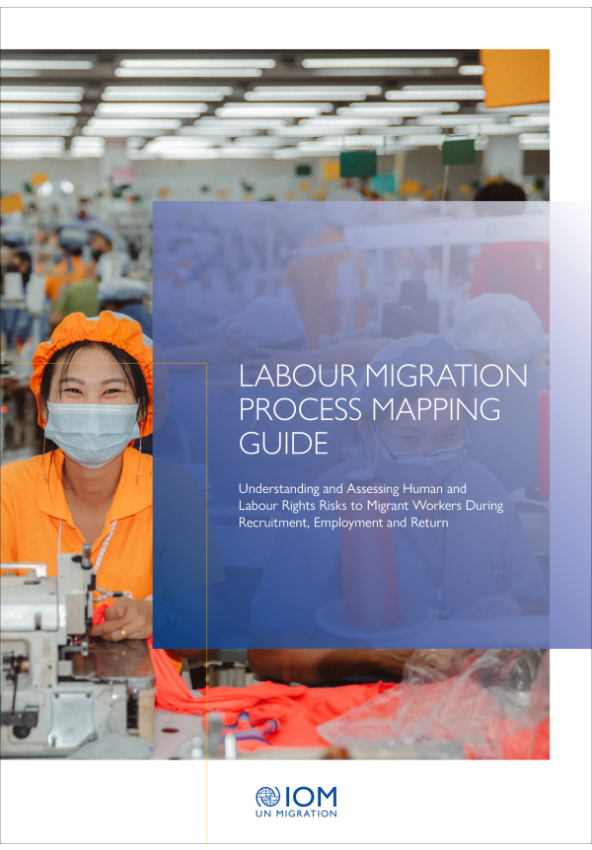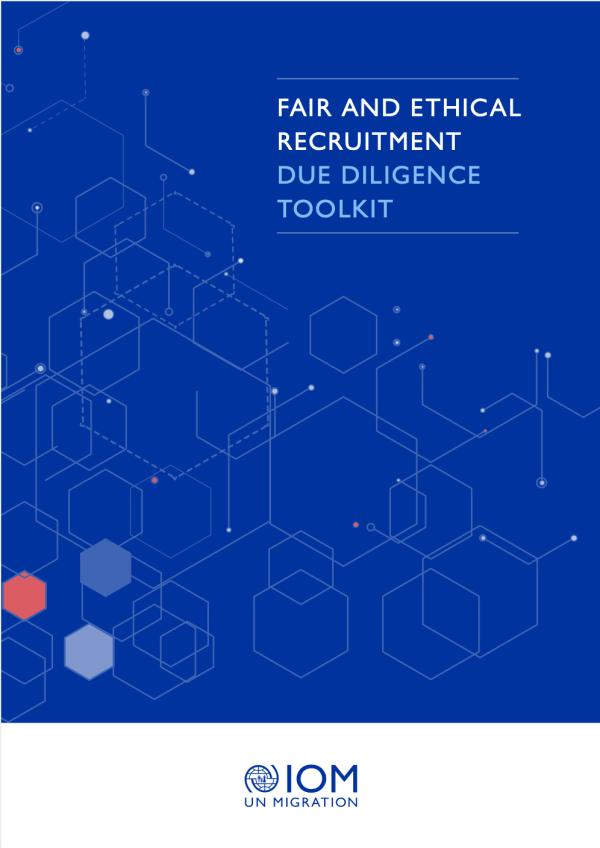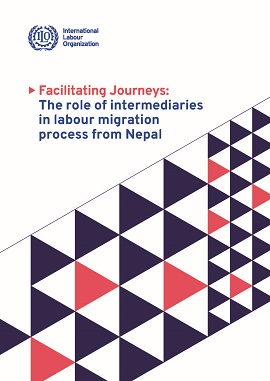Strengthening Solidarity and Safeguarding Rights – A Peer Learning Journey Between Ghana and Nigeria
Posted at April 8th 2025 12:00 AM | Updated as of April 8th 2025 12:00 AM
Region/Country : ,
|Themes : , , , ,
ILO opens the 2023 Global Media Competition on Labour Migration
Posted at September 25th 2023 12:00 AM | Updated as of September 25th 2023 12:00 AM
Region/Country :
|Themes : , , , , ,
Regulating international labour recruitment in the domestic work sector: A review of key issues, challenges and opportunities
Based on a report written by Leanne Melnyk. It addresses the process of international recruitment of workers and highlights both the specific needs and vulnerabilities faced by migrant domestic workers, as well as the main issues and challenges, and innovative practices for better regulation of international recruitment in the domestic work sector.
Type of document :
Country/Region :
Year of publication :
Theme : , , , , ,
Temporary labour migration: Two studies on workers’ perspectives and actions
This report gathering two studies on workers organizations’ experience with temporary labour migration is part of a larger ILO project to gather knowledge on temporary labour migration.
The views on temporary labour migration vary greatly, including among ILO constituents. In light of the various concerns that the complex dynamics of temporary labour migration raise, it is crucial for the Office to capture constituents’ perspectives to enrich the debate. This document is an input from the Workers’ side to this process.
Type of document :
Country/Region :
Year of publication :
Theme : , , ,
IOM-MPI Issue in Brief No. 1 - Labour Migration from Colombo Process Countries: Good practices, challenges and ways forward
International migration has occurred throughout history and regions of the world. Human mobility to, from and within Asia, however, has certain distinctive features, and Asia represents arguably the most dynamic region, with significant intra- and extra-regional migration and some countries being simultaneously origins of and destinations for migrants.
The Migration Policy Institute (MPI) and the International Organization for Migration (IOM) Regional Office for Asia and the Pacific today launched an issue briefs series focusing in particular on labour migration in the region. The eight-part series also will examine diaspora engagement in Asia and climate-induced migration.
The first issue brief, Labour Migration from the Colombo Process Countries, examines labour migration from the 11 Colombo Process countries (Afghanistan, Bangladesh, China, India, Indonesia, Nepal, Pakistan, the Philippines, Sri Lanka, Thailand and Viet Nam). In 2010, an estimated 4.2 million workers migrated from these countries through official channels, many leaving on a temporary basis to work in the Middle East.
The Philippines sent the largest number (nearly 1.5 million), followed by India (641,000) and Indonesia (576,000). Overall, an estimated 44.7 million migrants from the region are living outside their country of origin.
Since 2005, the Colombo Process countries have taken concrete, proactive steps to manage the migration flows and protect their citizens working abroad, strengthening their legislative and administrative frameworks addressing recruitment regulation and welfare protection, as well as signing new accords with key destination countries. Despite the progress, however, the brief details a number of remaining challenges and highlights 10 possible areas of focus for governments.
“Governments in Colombo Process countries face a formidable task: creating efficient and equitable migration systems that benefit labour migrants and their families while contributing to long-term economic growth and development in countries of origin and destination,” said Andy Bruce, IOM regional director for Asia and the Pacific.
In June, IOM and MPI will publish the second issue brief, this one focusing on migrant health issues in the Asia-Pacific region. Subsequent briefs will be published every month through December, and will be available at IOM Online Bookstore and Migration Policy Institute.
Type of document :
Country/Region : , , , , , , , , , , ,
Year of publication :
Theme : , ,
National Assessment of Labour Migration Policies, Legislation, Practices, and Structures in Nigeria
Nigeria, with over 140 million inhabitants, is a country of origin, transit, and destination for diverse migratory configurations, both internal and international – seasonal labour migration, undocumented or irregular migration, internal displacements, human trafficking, female migration, and migration of skilled professionals. There is a general lack of current information on demographic dynamics in the country, however, particularly concerning data on both stocks and flows of migrants within and outside the country.
In this context, this report covers data collection and analysis, which looks at data sources on international migration and intraregional migration, with emphases on Nigerian migrants and migrant workers. There is an overview of recruitment and support services, as well as policy formulation and challenges. International structures and inter-institutional collaboration are discussed based on an in-depth evaluation of the institutional structures in Nigeria. In addition, a background of migrants’ remittances and forms of remittances are analysed, taking into consideration remittance flows and uses, as well as the policy measures necessary to enhance the impact of remittances.
Moreover, the report covers the current national legislation and international norms regarding labour migration and the bilateral agreements existing between Nigeria and other African countries. In conclusion, recommendations have been provided on all the relevant issues contained in the report pertaining to data collection, recruitment and support services, institutional structures and inter-institutional collaboration, migrants’ remittances, and national legislation and international norms in order to formulate a comprehensive action plan detailing the way forward for labour migration management in Nigeria.
Type of document :
Country/Region : ,
Year of publication :
Theme : , , ,
IOM-MPI Issue in Brief No. 4 - Regulating Private Recruitment in the Asia-Middle East Labour Migration Corridor
The Middle East represents one of the most sought-after and competitive labour markets in the world, with an estimated 10 million contract workers in the Gulf states alone – 70 per cent of whom are Asian.
The vast majority of this temporary labour movement is brokered by recruitment agencies; and with the supply of labour overwhelmingly outweighing demand, oversight of recruitment practices is extremely difficult. Migrant workers are willing to pay a stiff premium to work in the Middle East, even in the face of onerous placement fees and less-than-ideal work and living conditions once at destination.
In Regulating Private Recruitment in the Asia? Middle East Labour Migration Corridor, author Dovelyn Rannveig Agunias examines how sometimes unscrupulous recruitment agencies take advantage of the migrants they purport to serve, by charging excessive placement fees and offering expensive pre-departure loans.
The issue brief, the fourth in a series launched by the Migration Policy Institute (MPI) and the International Organization for Migration’s Regional Office for Asia and the Pacific, discusses the policy options that could be implemented to curb abuses by increasing government intervention in recruitment operations.
Available policy levers for regulating recruitment practices are many and should aim to achieve the following overarching goals: (1) reduce the number of recruitment agencies to an optimal level to prevent cut-throat competition, (2) bring subagents and brokers into the formal sector, (3) regulate transactions among recruiters and between recruiters and employers and (4) harmonize regulations governing recruitment agencies at origin and destination.
The issue brief suggests that governments at both origin and destination should become involved by introducing parallel measures (such as provision of equal treatment and basic rights) that empower labour migrants and give them the needed negotiating leverage in an otherwise unequal employment relationship.
The IOM-MPI issue briefs, a monthly joint-publication offering succinct insights on migration issues affecting the Asia-Pacific region today, are available at IOM Online Bookstore and Migration Policy Institute.
Type of document :
Country/Region : ,
Year of publication :
Theme : , ,
Labour Migration Process Mapping Guide: Understanding and Assessing Human and Labour Rights Risks to Migrant Workers During Recruitment, Employment and Return
The Labour Migration Process Mapping Guide aims to help business enterprises identify, mitigate, and address human and labour rights risks faced by migrant workers in global supply chains. It provides step-by-step instructions on how to retrace the steps that migrant workers take from their communities of origin to their workplaces in destinations, and determine the effectiveness of existing recruitment management systems to prevent and address forced labour risks.
Designed primarily for business enterprises with complex international supply chains where migrant workers are present, the Guide builds on the United Nations Guiding Principles on Business and Human Rights (UNGP) and relevant international human rights, labour standards and frameworks on responsible business conduct.
Notably, the Guide was a collaborative effort developed in consultation with governments, civil society, migrant workers and the private sector, as well as by the collection of good practices by employers, multinational enterprises and labour recruiters.
Three supporting tools, which include effective interview techniques and key considerations to ensure migrant worker safety and well-being, are also attached in the Guide. They are:
- Migrant Worker Interview Tool
- Employer Management Interview Tool
- Labour Recruiter Management Interview Tool
Type of document :
Country/Region :
Year of publication :
Theme : ,
Fair and Ethical Recruitment Due Diligence Toolkit by IOM
The International Organization for Migration (IOM) Fair and Ethical Recruitment Due Diligence Toolkit was developed to support business enterprises in fulfilling their responsibility to respect human rights in the context of international recruitment. It provides practical tools that enterprises can use to conduct comprehensive due diligence in line with the UN Guiding Principles on Business and Human Rights (UNGPs), the OECD Due Diligence Guidance for Responsible Business Practice, and IOM’s Migrant Worker Guidelines (MWGs). It can be used by enterprises to develop or strengthen due diligence processes in directly recruiting and managing business relationships with labour recruiters and private employment agencies that place migrant workers.
The tools within the Toolkit contain detailed guidelines and practical recommendations on how the due diligence processes described in the UNGPs and MWGs can be operationalized. The tools include interactive features that will direct users to the next due diligence process or the corresponding actions that are recommended for them to take. Enterprises may directly use or edit the tools to adapt to the unique nature of their operations and business relationships.
Tools to operationalize fair and ethical recruitment due diligence:
- 1. Embedding fair and ethical recruitment principles into policies and management systems
- 2. Identifying and assessing adverse human and labour rights impacts on migrant workers
- 3. Preventing and mitigating adverse human and labour rights impacts on migrant workers
- Corrective Action Plan Template (linked to the Self-assessment Checklist)
- Training Management Tool
- Pre-departure Orientation Checklist
- Post-arrival Orientation Template
- 4. Tracking implementation and results
- 5. Communicating how adverse impacts are addressed
- 6. Providing access to remedy
Access the full Toolkit here.
For questions, please email iom.dd.support@iom.int.
Type of document :
Country/Region :
Year of publication :
Theme : , , ,
Facilitating Journeys: The role of intermediaries in labour migration process from Nepal
What happens after the decision to migrate for work has been made? What steps do prospective migrants take, where do they obtain information and what services do they seek? This infographic is based on qualitative research amongst migrant workers that examines the wide range of intermediaries that workers encounter in their migration journey.
As part of its Integrated Programme on Fair recruitment (FAIR), a global programme supported by the Swiss Development Cooperation, the ILO in Nepal commissioned a study amongst prospective and returning migrant workers to document their experience and in particular their interaction with various intermediaries that are involved in the migration process. Qualitative data was collected through in-depth interviews with 32 men and 9 women migrant workers, originating from 5 provinces, that were either abroad or had recently returned to Nepal.
This infographic illustrates the collection of narratives from migrant workers and builds a picture of their experiences after deciding to migrate. Who do workers interact with as they prepare their journeys? Where do they gather information? How do they prepare for interviews and who supports the processing of job applications and contracts? How are visas obtained, and where do workers receive orientation and training? What costs do these various services amount to? Furthermore, what network of intermediation and support do workers connect with one they have reached their destination? And, finally, who do workers turn to settle outstanding issues upon return to Nepal?
Type of document :
Country/Region :
Year of publication :
Theme : , , , ,
Subscribe to the Fair Recruitment Initiative Newsletter
Sign up to receive news delivered to your inbox.

